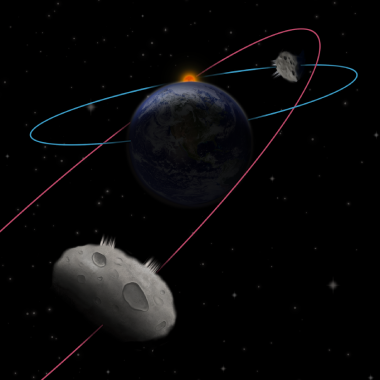Bringing dark comets to light
Article Highlights
- A Michigan State University post-doctoral fellow discovered seven new dark comets in our solar system.
- This discovery doubles the population of known dark comets and identifies two distinct types of dark comets.
- These objects could help scientists gather data to uncover answers about the formation of our planet.
Research led by Michigan State University’s College of Natural Science has uncovered seven new dark comets in our solar system. With this discovery, the team has doubled the population of known dark comets and is the first to identify two distinct types based on differences observed in orbit and size.
“One of the most important reasons why we study small bodies, like asteroids and comets, is because they tell us about how material is transported around the solar system,” said Darryl Seligman, postdoctoral fellow in MSU’s top-ranked Department of Physics and Astronomy.

“Dark comets are a new class of near-Earth objects that may contain water, so they’re a new potential source for delivering materials to Earth which were necessary for the development of life,” he explained. “The more we can learn about them, the better we can understand their role in our planet’s origin.”
The research, led by Seligman and published in the latest issue of the Proceedings of the National Academy of Sciences, not only uncovers seven new dark comets, but also compares the total known population to identify two distinct types.
First, outer dark comets are large objects with eccentric orbits, similar to the Jupiter Family Comets, which may originate in the outer solar system. Second, inner dark comets are smaller objects with nearly circular orbits that travel in the inner solar system, closer to Earth, and may originate in the asteroid belt.
“The interesting thing about these objects is that they look like asteroids, but their motion resembles that of comets,” said research co-author Davide Farnocchia, navigation engineer at the NASA Jet Propulsion Laboratory. “This is a puzzle that challenges the way we have always classified objects either as asteroids or comets.”
Dark comets are a relatively recent discovery. In 2003, scientists noticed the trajectory of “asteroid” 2003 RM had moved slightly from its expected orbit. That movement could not be explained by accelerations typical for asteroids.
Then, interstellar object ‘Oumuamua passed through our solar system and perplexed astronomers in 2017. Like typical asteroids and comets, it was moving primarily due to the gravitational pull of other objects in our solar system, like the Sun.
However, astronomers also found ‘Oumuamua was accelerating beyond that, likely due to the release of previously trapped gas. The strength of the added propulsion from such outgassing defied that of typical asteroids and matched a comet’s pace. The problem? ‘Oumuamua was missing the signature, bright dust tail of a comet. Thus, it could not be classified easily as an asteroid or a comet.
In 2023, Farnocchia and Seligman each published research which, together, identified seven objects within our solar system that mirrored the same unusual characteristics of ‘Oumuamua. They observed the objects using several facilities, including the European Southern Observatory’s Very Large Telescope. Through their work, the objects were categorized as members of an entirely new class of objects—the first seven dark comets.
"The discovery of more and different types of dark comets whizzing through the solar system is a prime example of why NSF continues to support the innovative research of postdoctoral scientists," says Louise Edwards, program director of the National Science Foundation Astronomy and Astrophysics Postdoctoral Fellowships program.
Their newly published research not only expands the world’s knowledge of such near-Earth objects, but also prompts numerous future research opportunities. Whether that involves uncovering exactly where dark comets originate from or confirming that dark comets could have delivered critical materials to Earth long ago, Seligman says the future is anything but dark.
“Expanding our knowledge on dark comets helps to contextualize ‘Oumuamua, which was such a serendipitous event that we can no longer observe since it has exited our solar system,” he said.
“What many people may not think about on a regular basis is that the solar system is a chaotic place,” he continued. “We don’t know where things come from, but with the 14 dark comets we now know about that are orbiting within our solar system, there are windows of opportunity in the next few years for us to gather more data and hopefully uncover answers about the formation of our own planet.”
Seligman’s work is supported by an NSF Astronomy and Astrophysics Postdoctoral Fellowship. The research is partially funded by a generous gift from Charles Simonyi to the NSF Division of Astronomical Sciences. The award is made in recognition of significant contributions to NSF-DOE Vera C. Rubin Observatory’s Legacy Survey of Space and Time.
- Categories: